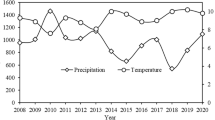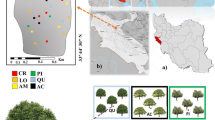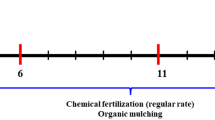Abstract
The chemical and microbial properties of afforested mine soils are likely to depend on the species composition of the introduced vegetation. This study compared the chemical and microbial properties of organic horizons and the uppermost mineral layers in mine soils under pure pine (Pinus sylvestris), birch (Betula pendula), larch (Larix decidua), alder (Alnus glutinosa), and mixed pine–alder and birch–alder forest stands. The studied properties included soil pH, content of organic C (Corg) and total N (Nt), microbial biomass (Cmic), basal respiration, nitrogen mineralization rate (Min-N), and the activities of dehydrogenase, acid phosphomonoesterase, and urease. Near-infrared spectroscopy (NIR) was used to detect differences in the chemical composition of soil organic matter under the studied forest stands. There were significant differences in Corg and Nt contents between stands in both O and mineral soil horizons and also in the chemical composition of the accumulated organic matter, as indicated by NIR spectra differences. Alder was associated with the largest Corg and Nt accumulation but also with a significant decrease of pH in the mineral soil. Microbial biomass, respiration, the percentage of Corg present as Cmic, Min-N, and dehydrogenase activity were the highest under the birch stand, indicating a positive effect of birch on soil microflora. Admixture of alder to coniferous stand increased basal respiration, Min-N, and activities of dehydrogenase and acid phosphomonoesterase as compared with the pure pine stand. In the O horizon, soil pH and Nt content had the most important effects on all microbial properties. In this horizon, the activities of urease and acid phosphomonoesterase did not depend on microbial biomass. In the mineral layer, however, the amount of accumulated C and microbial biomass were of primary importance for the enzyme activities.





Similar content being viewed by others
References
Adamczyk B, Kitunen V, Smolander A (2008) Protein precipitation by tannins in soil organic horizon and vegetation in relation to tree species. Biol Fertil Soils 45:55–64
Anderson JPE, Domsch KH (1978) A physiological method for the quantitative measurement of microbial biomass in soils. Soil Biol Biochem 10:215–221
Andersson S, Nilsson SI (2001) Influence of pH and temperature on microbial activity, substrate availability of soil solution bacteria and leaching of dissolved organic carbon in a mor humus. Soil Biol Biochem 33:1181–1191
Bauhus J, Paré D, Côté L (1998) Effects of tree, stand age and soil type on soil microbial biomass and its activity in a southern boreal forest. Soil Biol Biochem 30:1077–1089
Berg B (2000) Litter decomposition and organic matter turnover in northern forest soils. For Ecol Manage 133:13–22
Bolan NS, Hedley MJ, White RE (1991) Processes of soil acidification during nitrogen cycling with emphasis on legume based pastures. Plant Soil 134:53–63
Bradley RL, Fyles JW (1996) Interactions between tree seedling roots and humus forms in the control of soil C and N cycling. Biol Fertil Soils 23:70–79
Caldwell BA (2005) Enzyme activities as a component of soil biodiversity: a review. Pedobiologia 49:637–644
Camiré C, Coté B, Brulotte S (1991) Decomposition of roots of black alder and hybrid poplar in short-rotation plantings: nitrogen and lignin control. Plant Soil 138:123–132
Carreiro MM, Sinsabaugh RL, Repert DA, Pankhurst DF (2000) Microbial enzyme shifts explain litter decay responses to simulated nitrogen deposition. Ecology 81:2359–2365
Chiti T, Certini G, Puglisi A, Sanesi G, Cepperucci A, Forte C (2007) Effects of associating a N-fixer species to monotype oak plantations on the quantity and quality of organic matter in minesoils. Geoderma 138:162–169
Chodak M, Pietrzykowski M, Niklińska M (2009) Development of microbial properties in a chronosequence of sandy mine soils. Appl Soil Ecol 41:259–268
de Mora AP, Ortega-Calvo JJ, Cabrera F, Madejón E (2005) Changes in enzyme activities and microbial biomass after “in situ” remediation of a heavy metal-contaminated soil. Appl Soil Ecol 28:125–137
Doran JW, Parkin TB (1996) Quantitative indicators of soil quality: a minimum data set. In: Doran JW, Jones AJ (eds) Methods for assessing soil quality. Soil Science Society of America, special publication no. 49. Soil Science Society of America, Madison, pp 25–37
Foley WJ, McIlwee A, Lawler I, Aragones L, Woolnough AP, Berding N (1998) Ecological applications of near infrared reflectance spectroscopy—a tool for rapid, cost-effective prediction of the composition of plant and animal tissues and aspects of animal performance. Oecologia 116:293–305
Giardina CP, Huffman S, Binkley D, Caldwell B (1995) Alders increase phosphorus supply in a Douglas-fir plantation. Can J For Res 25:1652–1657
Gil-Sotres F, Trasar-Cepeda C, Leirós MC, Seoane S (2005) Different approaches to evaluating soil quality using biochemical properties. Soil Biol Biochem 37:877–887
Graham MH, Haynes RJ (2004) Organic matter status and the size, activity and metabolic diversity of the soil microflora as indicators of the success of rehabilitation of sand dunes. Biol Fertil Soils 39:429–437
Hart SC, Binkley D, Perry DA (1997) Influence of red alder on soil nitrogen transformations in two conifer forests of contrasting productivity. Soil Biol Biochem 29:1111–1123
Hurlbert SH (1984) Pseudoreplication and the design of ecological field experiments. Ecol Monographs 54:187–211
Hüttl RF, Weber E (2001) Forest ecosystem development in post-mining landscapes: a case study of the Lusatian lignite district. Naturwissenschaften 88:322–329
Izquierdo I, Caravaca F, Alguacil MM, Hernández G, Roldán A (2005) Use of microbiological indicators for evaluating success in soil restoration after revegetation of a mining area under subtropical conditions. Appl Soil Ecol 30:3–10
Johansson M-B (1995) The chemical composition of needle and leaf litter from Scots pine, Norway spruce and white birch in Scandinavian forests. Forestry 68:49–62
Johnson DW, Curtis PS (2001) Effects of forest management on soil C and N storage: meta analysis. For Ecol Manage 140:227–238
Kandeler E (1996) Urease activity by colorimetric technique. In: Schinner F, Öhlinger R, Kandeler E, Margesin R (eds) Methods in soil biology. Springer, Berlin, pp 171–174
Kanerva S, Kitunen V, Loponen J, Smolander A (2008) Phenolic compounds and terpenes in soil organic horizon layers under silver birch, Norway spruce and Scots pine. Biol Fertil Soils 44:547–556
Katzur J, Böckner L, Stähr F (1999) Humus- und Bodenentwicklung in Kippen-Forstökosystemen. AFZ Der Wald 25:1339–1341
Kiikkilä O, Kitunen V, Smolander A (2006) Dissolved soil organic matter from surface organic horizons under birch and conifers: degradation in relation to chemical characteristics. Soil Biol Biochem 38:737–746
Liu S, Li X, Niu L (1998) The degradation of soil fertility in pure larch plantations In the northeastern part of China. Ecol Eng 10:75–86
Ludwig B, Khanna PK (2001) Use of near infrared spectroscopy to determine inorganic and organic carbon fractions in soil and litter. In: Lal R, Kimble JM, Follett RF, Stewart BA (eds) Assessment methods for soil carbon. Adv Soil Sci. Lewis, Boca Raton, pp 361–370
Margesin R (1996) Acid and alkaline phosphomonoesterase activity with substrate p-nitrophenyl phosphate. In: Schinner F, Öhlinger R, Kandeler E, Margesin R (eds) Methods in soil biology. Springer, Berlin, pp 213–217
Menyailo OV, Hungate BA, Zech W (2002a) Tree species mediated soil chemical changes in a Siberian artificial Afforestation experiment. Plant Soil 242:171–182
Menyailo OV, Hungate BA, Zech W (2002b) The effect of single tree species on soil microbial activities related to C and N cycling in the Siberian artificial afforestation experiment. Plant Soil 242:183–196
Nannipieri P, Grego S, Ceccanti B (1990) Ecological significance of the biological activity in soil. In: Bollag JM, Stotzky G (eds) Soil biochemistry, vol 6. Marcel Dekker, New York, pp 293–355
Nannipieri P, Kandeler E, Ruggiero P (2002) Enzyme activities and microbiological and biochemical processes in soil. In: Burns RG, Dick RP (eds) Enzymes in the environment. Activity, ecology and applications. Marcel Dekker, New York, pp 1–33
Niemi RM, Vepsäläinen M, Erkomaa K, Ilvesniemi H (2007) Microbial activity during summer in humus layers under Pinus sylvestris and Alnus incana. For Ecol Manage 242:314–323
Niklińska M, Chodak M, Laskowski R (2005) Characterization of the forest humus microbial community in a heavy metal polluted area. Soil Biol Biochem 37:2185–2194
Pascual JA, Garcia C, Hernandez T, Moreno JL, Ros M (2000) Soil microbial activity as a biomarker of degradation and remediation processes. Soil Biol Biochem 32:1877–1883
Pietrzykowski M, Krzaklewski W (2007) An assessment of energy efficiency in reclamation to forestry. Ecol Eng 30:341–348
Priha O, Smolander A (1999) Nitrogen transformations in soil under Pinus sylvestris, Picea abies and Betula pendula at two forest sites. Soil Biol Biochem 31:965–977
Priha O, Grayston SJ, Hiukka R, Pennanen T, Smolander A (2001) Microbial community structure and characteristics of the organic matter under Pinus sylvestris, Picea abies and Betula pendula at two forest sites. Biol Fertil Soils 33:17–24
Quilchao C, Marańón T (2002) Dehydrogenase activity in Mediterranean forest soils. Biol Fertil Soils 35:102–107
Resh SC, Binkley D, Parrotta JA (2002) Greater soil carbon sequestration under nitrogen-fixing trees compared with Eucalyptus species. Ecosystems 5:217–231
Rothe A, Cromack K Jr, Resh SC, Makineci E, Son Y (2002) Soil carbon and nitrogen changes under Douglas-fir with and without red alder. Soil Sci Am J 66:1988–1995
Schlichting E, Blume HO (1966) Bodenkundliches Praktikum. Paul Parey, Hamburg
Seltmans PC, Hart SC, Boyle SI, Stark JM (2005) Red alder (Alnus rubra) alters community-level oil microbial function in conifer forests of the Pacific Northwest, USA. Soil Biol Biochem 37:1860–1868
Sheldrick BH, Wang C (1993) Particle size distribution. In: Carter MR (ed) Soil sampling and methods of analysis. Lewis, Boca Raton
Shenk JS, Workman JJ Jr, Westerhaus MO (1992) Application of NIR spectroscopy to agricultural products. In: Burns DA, Ciurczak EW (eds) Handbook of near-infrared analysis. Marcel Dekker, New York, pp 383–431
Simonsson M, Kaiser K, Danielsson R, Andreux F, Ranger J (2005) Estimating nitrate, dissolved organic carbon and DOC fractions in forest floor leachates using ultraviolet absorbance spectra and multivariate analysis. Geoderma 124:157–168
Sinsabaugh RL, Antibus RK, Linkins AE, McClaugherty CA, Rayburn L, Repert D, Weiland T (1993) Wood decomposition: nitrogen and phosphorus dynamics in relation to extracellular enzyme activity. Ecology 74:1586–1593
Smolander A, Kitunen V (2002) Soil microbial activities and characteristics of dissolved organic C and N in relation to tree species. Soil Biol Biochem 34:651–660
Šourková M, Frouz J, Fettweis U, Bens O, Hüttl RF, Šantrůčková H (2005) Soil development and properties of microbial biomass succession in reclaimed post mining sites near Sokolov (Czech Republic) and near Cottbus (Germany). Geoderma 129:73–80
Tan X, Chang SX, Kabzems R (2008) Soil compaction and forest floor removal reduced microbial biomass and enzyme activities in a boreal aspen forest soil. Biol Fertil Soils 44:471–479
Timm NH (2002) Applied multivariate statistics. Springer, New York
von Mersi W (1996) Dehydrogenase activity with the substrate INT. In: Schinner F, Öhlinger R, Kandeler E, Margesin R (eds) Methods in soil biology. Springer, Berlin, pp 243–245
Verburg PSJ, Johnson DW, Harrison R (2001) Long-term nutrient cycling patterns in Douglas-fir and red alder stands: a simulation study. For Ecol Manage 145:203–217
Waring RH, Running SW (1998) Forest ecosystems: analysis at multiple scales, 2nd edn. Academic, San Diego
Acknowledgment
The study was financed by the Polish Ministry of Science and Higher Education, grant no. PBZ/MNiSW/07/2006/06..
Author information
Authors and Affiliations
Corresponding author
Rights and permissions
About this article
Cite this article
Chodak, M., Niklińska, M. The effect of different tree species on the chemical and microbial properties of reclaimed mine soils. Biol Fertil Soils 46, 555–566 (2010). https://doi.org/10.1007/s00374-010-0462-z
Received:
Revised:
Accepted:
Published:
Issue Date:
DOI: https://doi.org/10.1007/s00374-010-0462-z




